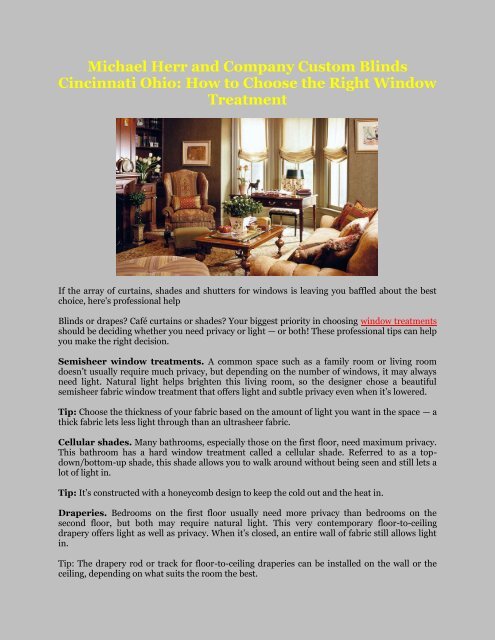Michael Herr and Company Custom Blinds Cincinnati Ohio How to Choose the Right Window Treatment
Create successful ePaper yourself
Turn your PDF publications into a flip-book with our unique Google optimized e-Paper software.
<strong>Michael</strong> <strong>Herr</strong> <strong>and</strong> <strong>Company</strong> <strong>Cus<strong>to</strong>m</strong> <strong>Blinds</strong><br />
<strong>Cincinnati</strong> <strong>Ohio</strong>: <strong>How</strong> <strong>to</strong> <strong>Choose</strong> <strong>the</strong> <strong>Right</strong> <strong>Window</strong><br />
<strong>Treatment</strong><br />
If <strong>the</strong> array of curtains, shades <strong>and</strong> shutters for windows is leaving you baffled about <strong>the</strong> best<br />
choice, here's professional help<br />
<strong>Blinds</strong> or drapes? Café curtains or shades? Your biggest priority in choosing window treatments<br />
should be deciding whe<strong>the</strong>r you need privacy or light — or both! These professional tips can help<br />
you make <strong>the</strong> right decision.<br />
Semisheer window treatments. A common space such as a family room or living room<br />
doesn’t usually require much privacy, but depending on <strong>the</strong> number of windows, it may always<br />
need light. Natural light helps brighten this living room, so <strong>the</strong> designer chose a beautiful<br />
semisheer fabric window treatment that offers light <strong>and</strong> subtle privacy even when it’s lowered.<br />
Tip: <strong>Choose</strong> <strong>the</strong> thickness of your fabric based on <strong>the</strong> amount of light you want in <strong>the</strong> space — a<br />
thick fabric lets less light through than an ultrasheer fabric.<br />
Cellular shades. Many bathrooms, especially those on <strong>the</strong> first floor, need maximum privacy.<br />
This bathroom has a hard window treatment called a cellular shade. Referred <strong>to</strong> as a <strong>to</strong>pdown/bot<strong>to</strong>m-up<br />
shade, this shade allows you <strong>to</strong> walk around without being seen <strong>and</strong> still lets a<br />
lot of light in.<br />
Tip: It’s constructed with a honeycomb design <strong>to</strong> keep <strong>the</strong> cold out <strong>and</strong> <strong>the</strong> heat in.<br />
Draperies. Bedrooms on <strong>the</strong> first floor usually need more privacy than bedrooms on <strong>the</strong><br />
second floor, but both may require natural light. This very contemporary floor-<strong>to</strong>-ceiling<br />
drapery offers light as well as privacy. When it’s closed, an entire wall of fabric still allows light<br />
in.<br />
Tip: The drapery rod or track for floor-<strong>to</strong>-ceiling draperies can be installed on <strong>the</strong> wall or <strong>the</strong><br />
ceiling, depending on what suits <strong>the</strong> room <strong>the</strong> best.
Roller shades. Whe<strong>the</strong>r you have a bathroom on <strong>the</strong> first floor or on <strong>the</strong> second, closely<br />
situated neighbors can require privacy. This easy-<strong>to</strong>-install roller shade is perforated, allowing<br />
light <strong>to</strong> filter through.<br />
Tip: Since window treatments at <strong>the</strong> back of tubs may be hard <strong>to</strong> reach, hardwire a roller shade<br />
so that you can conveniently manipulate it from a control panel or remote.<br />
Blackout curtains. Getting baby <strong>to</strong> sleep in <strong>the</strong> middle of <strong>the</strong> day can prove difficult with <strong>the</strong><br />
sun blaring in — but not with blackout shades. Have a blackout lining — a very dense fabric that<br />
light can’t penetrate — sewn on<strong>to</strong> <strong>the</strong> back of any drapery fabric.<br />
Tip: For absolute darkness, install floor-<strong>to</strong>-ceiling drapes 18 inches past each side of <strong>the</strong><br />
window. This will ensure that as little light as possible seeps in through cracks.<br />
Shutters. If your guests come for <strong>to</strong>tal relaxation, that may require sleeping in after <strong>the</strong> sun<br />
comes up. This bedroom has shutters installed with solid center panels <strong>to</strong> block out all light.<br />
This window treatment also blends seamlessly in<strong>to</strong> <strong>the</strong> creativity of <strong>the</strong> overall <strong>the</strong>me of <strong>the</strong><br />
room. Bravo!<br />
Tip: These shutters were painted red for high impact, but if you want a more <strong>to</strong>ned-down look,<br />
paint <strong>the</strong>m <strong>the</strong> same color as your walls <strong>and</strong> watch <strong>the</strong>m disappear.<br />
Stained glass. Should you have a great number of windows on or around your front door but<br />
want a little privacy, consider installing stained glass. This will turn your foyer in<strong>to</strong> a focal point<br />
<strong>and</strong> prevent passersby from getting a full look in<strong>to</strong> your home.<br />
Tip: A similar effect can be created with vinyl <strong>to</strong> save on cost. Contact a local sign company <strong>to</strong><br />
create this look for your home.<br />
Layered treatments. Blackout curtains or shades are often necessary in a TV or media room.<br />
This media room goes <strong>the</strong> extra mile in achieving <strong>to</strong>tal movie <strong>the</strong>ater darkness by layering a<br />
Roman shade <strong>and</strong> floor-<strong>to</strong>-ceiling draperies.<br />
Tip: The more fabric you add <strong>to</strong> your windows in your <strong>the</strong>ater or media room, <strong>the</strong> better <strong>the</strong><br />
acoustics will be.<br />
Create your dream space with cus<strong>to</strong>m window treatments


